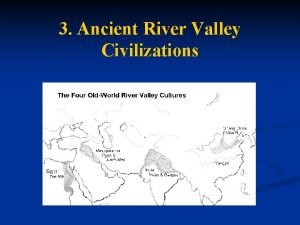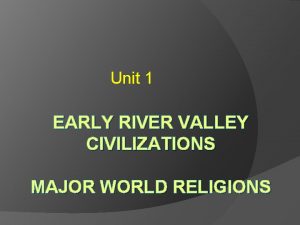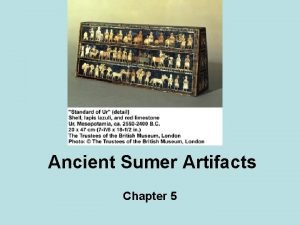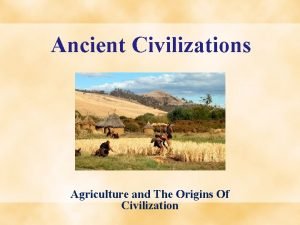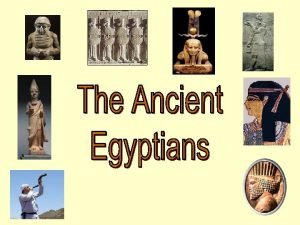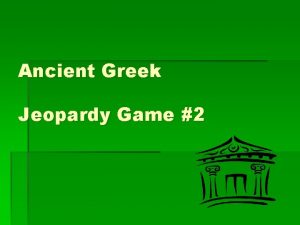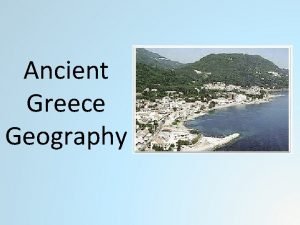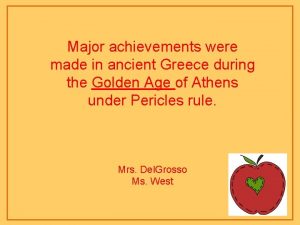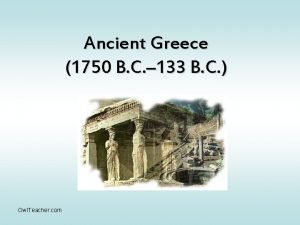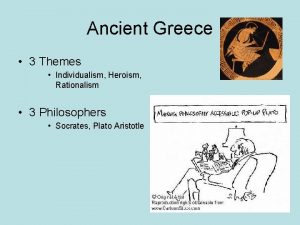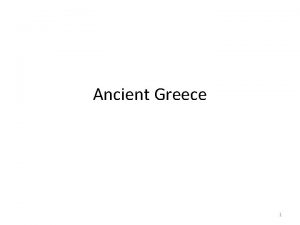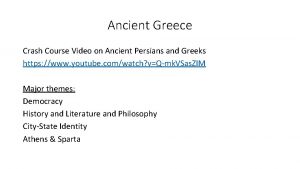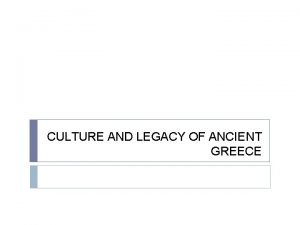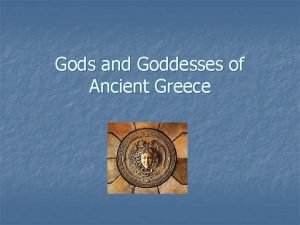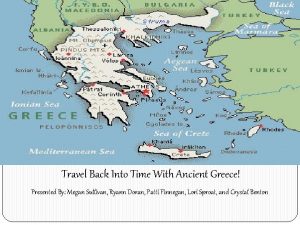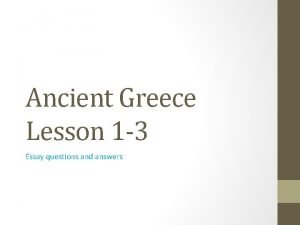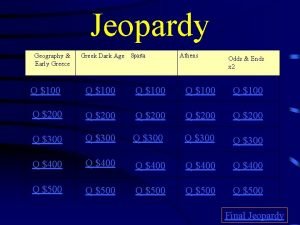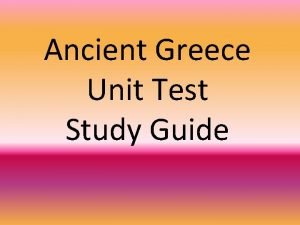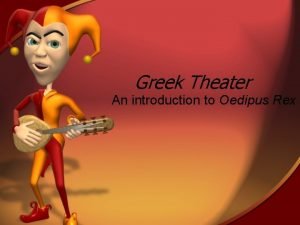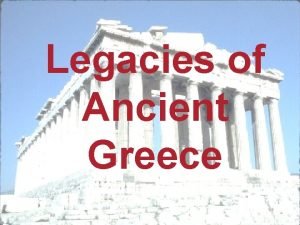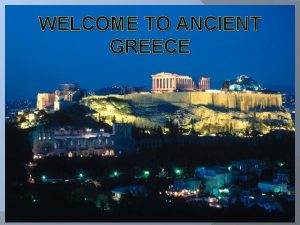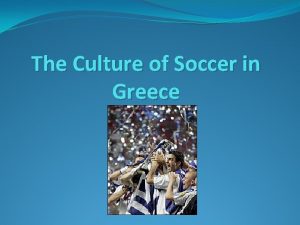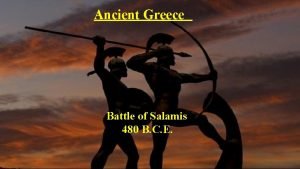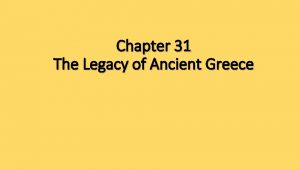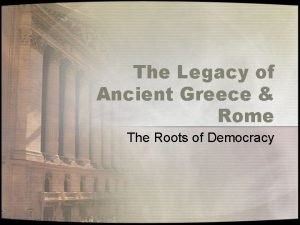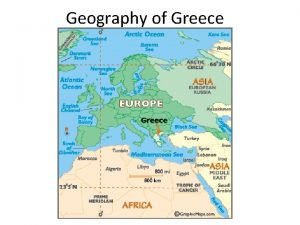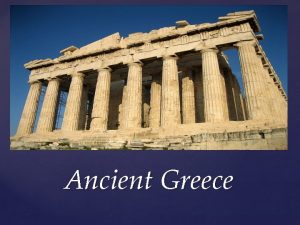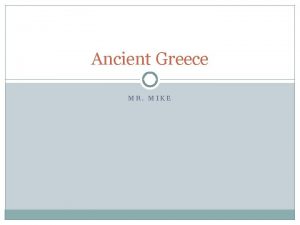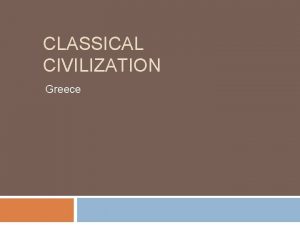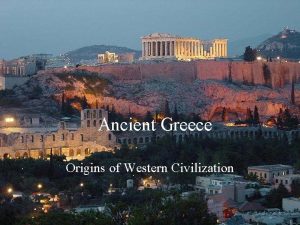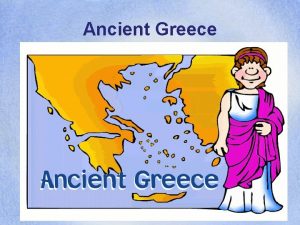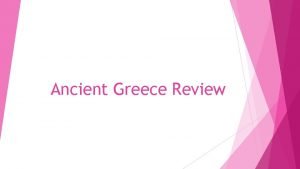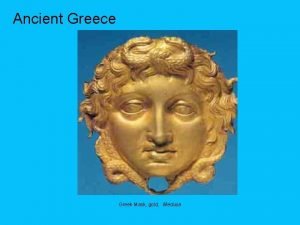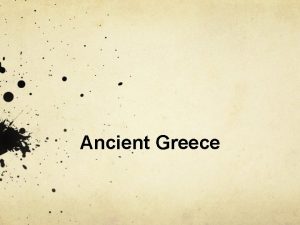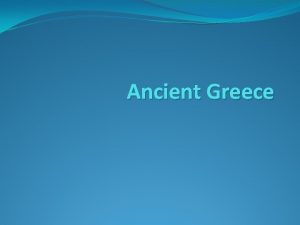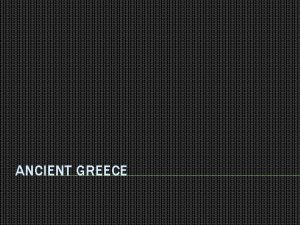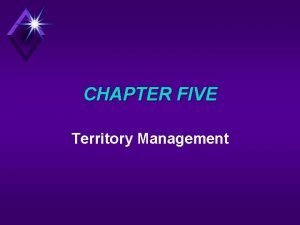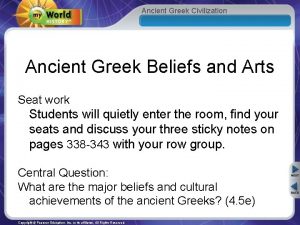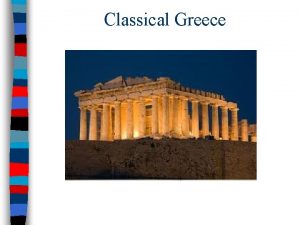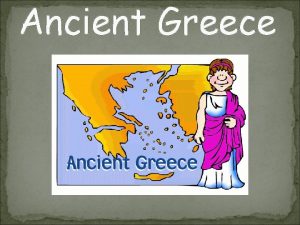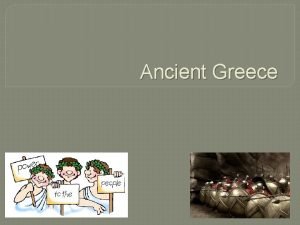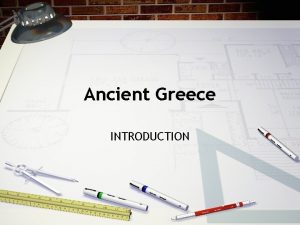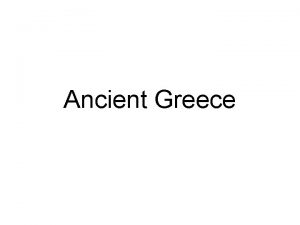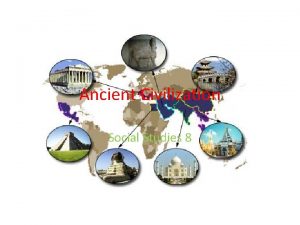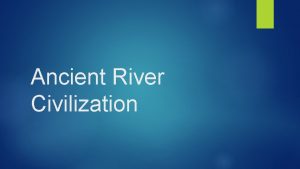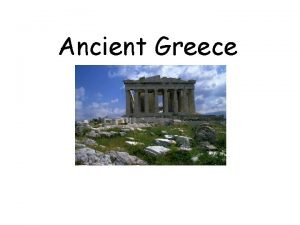Ancient Greece THE GREEK TERRITORY The Greek civilization




































- Slides: 36

Ancient Greece

THE GREEK TERRITORY ØThe Greek civilization started in the south of the Balkan Peninsula, but some Greeks lived on islands in the Aegean and Ionian seas and along the coast of Minor Asia (Turkey) ØAll these Greek territories were called HELLADA

THE HELLENES ØBecause Greece is made up of many islands, and has many tall mountains, the Greeks began to build citystates instead of one country. ØThe Hellenes shared the same geographic space, religion, culture and language

ANCIENT GREEK CIVILIZATION Ø Ancient Greek civilization developed between the 8 th and 1 st centuries B. C. ØTheir history is divided into 3 periods: ARCHAIC PERIOD (8 th-6 th centuries B. C): THE POLIS CLASSICAL PERIOD (5 th-first half of 4 th centuries B. C): ATHENS AND SPARTA HELLENISTIC PERIOD (second half of 4 th – 1 st centuries B. C): ALEXANDER THE GREAT

THE ARCHAIC PERIOD: 8 TH 6 TH CENTURIES BC THE BIRTH OF POLEIS= CITY-STATES ØThe poleis grew and new territories were colonised. ØIndependent city-states. laws, army, ØEach polis had its own currency and government. ØThe most important poleis: Athens and Sparta.

THE ARCHAIC PERIOD: 8 TH 6 TH CENTURIES BC THE GREEK EXPANSION ØPeriod of crisis because of the population increase and infertile land. ØMany Greeks emigrated and founded colonies around the Mediterranean sea. ØColonies had the same traditions and organizations as the poleis they came from, but they were independent. ØColonization spread Greek influence beyond its frontiers (ironworking, money, the alphabet and Greek art)

THE ARCHAIC PERIOD

THE ARCHAIC PERIOD ATHENS

THE ARCHAIC PERIOD SPARTA

THE CLASSICAL PERIOD: 5 TH – FIRST HALF OF 4 TH CENTURIES BC ATHENS AND SPARTA ØHegemony of Athens and Sparta ØSuccession of wars ATHENIAN POLITICAL SYSTEM. DEMOCRACY Athens was a democracy because all citizens could vote, but only half the people in Athens were citizens. Women, people born outside of Athens, and slaves could not vote. SPARTIAN POLITICAL SYSTEM. OLIGARCHY Sparta was an oligarchy (the government was in charge of a few aristocrats) Two kings held religious and military power

THE CLASSICAL PERIOD

THE CLASSICAL PERIOD ATHENS: EXAMPLE OF DEMOCRATIC GOVERNMENT ASSEMBLY OR ECCLESIA (debated and voted on laws) Magistrates (took decisions) Proposed by election or lot People’s tribunals (judged) The council of 500 (drafted laws) Proposed by lot Elected annually made up of free male adults sons of Athenian fathers and mothers

THE CLASSICAL PERIOD ØPower exercised by a small group of individuals (oligarchy) ØMost Greek poleis adopted this form of government SPARTIAN POLITICAL SYSTEM. OLIGARCHY ASSEMBLY OR APPELLA (consultative body) Five Magistrates (monitored citizena’ private lives and compliance with the law) elected Gerousia or Council of Elders (made proposals for laws) 2 hereditary kings (religious and military power) 28 elders aged over 60 made up of adult men (aged over 30) sons of Athenian fathers

THE CLASSICAL PERIOD: A PERIOD OF WARS THE GRECO-PERSIAN WARS. ATHENIAN HEGEMONY THE PELOPONNESIAN WAR. SPARTIAN HEGEMONY ØEarly 5 th century BC, Persians tried to conquer continental Greece ØMost poleis united to fight the enemies ØVictories over the Persians at the Battles of Marathon (490 BC) and Salamis (480) ØAthens gained military prestige and became the most powerful polis under Pericles (5 th century BC) ØThe Delian League was an alliance of poleis intended to prevent future Persian attacks Pericles - A leader and ØPolitical, economical and cultural splendour of Athens threatened the interests of Sparta ØTwo opposed groups were created: one led by Athens and another one led by Sparta ØThe Peloponnesian War (431 BC – 404 BC) ended up with the Spartian victory ØEconomic crisis and internal conflicts left the Greek poleis greatly weakened statesman during the golden age of Greece. He helped democracy to flourish and led great building projects in Athens

THE HELLENISTIC PERIOD: 338 BC-30 BC ØMid 4 th century King Phillip of Macedonia imposed his rule over the Greek poleis except for those in Sparta ØAlexander The Great, his son, conquered Persia, Egypt, Middle East and Northern India

THE HELLENISTIC PERIOD: 338 BC-30 BC ØNew cities were created: Alexandria, Pergamo ØGreek became the official language in all conquered territories ØGreek art and culture became fashionable ØGreat cultural splendour (art, poetry, theatre, science and mathematics) ØImportant buildings: libraries, museums, sanctuaries ØAt Alexander’s death, his generals divided up the empire, adopted the titles of kings and created kingdoms (The Hellenistic monarchies)

GREEK SOCIETY CITIZENS MALE CITIZENS FOREIGNERS NONCITIZENS WOMEN SLAVES • Could take part in politics • Had to pay taxes and serve in the army • Of parents born in the polis Free, could fight in the army, worked in trade and crafts but could not own land or houses. free or slaves, had no rights. They were always under the rule of a man. not free and worked for a family. They worked in agriculture o. R domestic work.

GREEK ECONOMY CRAFTS making pottery (pots, vases… made of ceramics), clothes (made of fabric: leather, linen, wool…), furniture (made of wood) by hand. TRADE LIVESTOCK FARMING Øraising animals to get meat, milk, eggs or fur. ØIt was essentially focused on the breeding of goats, sheep, pigs, oxen and horses AGRICULTURE ØInfertile soil ØSpecialised in wheat, vines and olive trees ØAlmost all the land belonged to a limited number of landowners Øexchanging or buying products like fish, vegetables, pots. . . ØProducts from Greek poleis were sold abroad and food, wood and copper were imported. ØThey used silver coins called dracmas. ØThere were small shops in Greek poleis. ØPeasants sold their crops in the poleis. ØCraftsmen sold their products in their workshops. ØThe place where they used to do this was a market called Agora.

AGORA

JOBS IN ANCIENT GREEK SOLDIER / WARRIOR SCULPTOR BLACKSMITH SAILOR ACTOR CARPENTER CRAFTSMAN / ARTISAN FISHERMAN DOCTOR PRIEST / PRIESTESS

DAILY LIFE IN ANCIENT GREEK CLOTHING Men and women used to wear simple tunics and warm cloaks, made of linen or wool, dyed a bright color, or bleached white; a belt and sandals. Only rich people could wear much jewelry: rings, earrings, bracelets, necklaces, … They used perfume, made by boiling flowers and herbs. The ancient Greeks could buy cloth and clothes in the agora, the marketplace, but that was expensive. The first real hat, called petasos, was invented by the ancient Greeks.

DAILY LIFE IN ANCIENT GREEK HOUSE Greek houses were made up of two or three rooms, built around an open air courtyard or patio, made of stone, wood or clay bricks. Larger homes might also have a kitchen, a bathroom, a men's dining room (Andron), and perhaps a woman's sitting area (Gynaeceum). Courtyard or patio Symposium, social events with food and wine, were held in the andron.

DAILY LIFE IN ANCIENT GREEK FOOD The soil was not very fertile along the coastline. But the ancient Greeks used systems of irrigation to help solve that problem. People in the countryside worked in agriculture and were very poor. Many farms were very small All over Greece, the people grew olives, grapes, and figs. They kept goats, for milk and cheese. In the plains, where the soil was more fertile, they also grew wheat to make bread. Fish, seafood, and home-made wine were very popular food items In some of the larger Greek city-states, meat could be purchased in cook shops. But Greeks didn’t use to eat it

DAILY LIFE IN ANCIENT GREEK ENTERTAINMENT Theatres were built outside. All of the actors were men. Each actor played several parts in the play by wearing a different mask for each part. Greeks invented theatre. Women were not allowed to go to theatre. The Olympic Games were sporting events to honour the gods. The most popular ones took place in Olympia and took 7 days. They were held every four years and male athletes and spectators from all Greek regions attended these events. In the home, the women's rooms were in the back. The front rooms were sometimes used by the men in the household for "symposia" (banquets). The only women who attended these parties were the entertainers who played music and danced for the guests.

BELIEVES GODS AND HEROES ØAncient Greeks were polytheistic. They believed in many gods. In the past, people used to believe in different gods or goddesses to understand the life events. ØGods and goddesses lived on Mount Olympus and looked like humans but were immortal and had extraordinary powers. ØEach polis had its own protective divinity ZEUS ATHENEA ØGreeks also believed in heroes, sons of gods and humans (demigods). ØAlthough they were mortals, they could perform prodigious deeds. ØThey also believed in fantastic creatures, such as cyclopes and centaurs. HERACLES ØThe Greek wrote myths or accounts of the deeds of their gods and heroes, which established Greek mythology.

GREEK GODS Zeus Hades Ares Apollo Hermes Hephaestus Poseidon Dionysus

GREEK GODDESSES Athenea Hera Hestia Artemis Demeter Aphrodite

BELIEVES VENERATION OF GODS ØAt home, the head of the household officiated the ritual worship of the goddess of the home (Hestia) and of their ancestors. ØIn temples, the priests would officiate the ritual worship, which involved animal sacrifices and processions carrying offerings ØIn sanctuaries, where Greek from all the poleis would meet to honour their gods. These celebrations combined theatre performances and sporting competitions. ØOlympia was one of the most important sanctuaries ØGreeks used oracles to ask gods about the future. Priests and priestesses answered on behalf of gods. The most widely consulted oracle was Apollo, in Delphi.

GREEK ARCHITECTURE: THE TEMPLE Ø The temple was the symbolic house of gods, usually built on the city’s highest ground, the acropolis. Ø Each contained a statue of the corresponding god. ØIt was made of stone and marble on a rectangular base. ØThe pitched roof was supported by walls surrounded by columns. OFFERINGS AND DIVINITY’S TREASURE ARE KEPT HERE MAIN ROOM: GOD’S STATUE VESTIBULE

GREEK ARCHITECTURE: THE TEMPLE Ø They created the architectonic orders (sets of rules which established the placement and the proportions between the parts of a building) ØThere were 3 orders: Doric, Ionic and Corinthian DORIC IONIC CORINTHIAN

GREEK ARCHITECTURE: THE Ø The most important temples were built in the 5 century BC in the Acropolis of TEMPLE Athens. th THE ACROPOLIS The Acropolis is not a single building but a number of temples built on a hill overlooking Athens. Although there are many Acropolises (the word meaning high city) in Greece we tend to associate the name with the one in Athens. THE PARTHENON • Temple of Dorian style on the Athenian Acropolis, dedicated to the goddess Athena, considered the patron of Athens. • Designed by architects Iktinos and Kallikrates • Sculptor Phidias decorated it with sculptures. THE ERECTHEION temple of Ionic style on the north side of the Acropolis of Athens.

GREEK SCULPTURE ØMost sculptures and reliefs represented deities and heroes and were found in temples. ØGreek Sculptors were interested in representing the beauty of the naked human body. ØSculptors followed a canon (to apply certain proportions to a body) ØMost sculptures were made in marble and bronze and painted in bright coulours. ARCHAIC PERIOD CLASSICAL PERIOD HELLENISTIC PERIOD Rigid and schematic, restrained smile, walking pose More natural Movements and feelings, expressive face Kouros Kore Discobolus by Myron Laocoön and his sons

PHILOSOPHY, SCIENCE AND LITERATUE Ø Ø Ø Ø Ancient people explained the natural phenomena they didn’t understand through myths A philosopher is someone who tries to explain the nature of life. At first, Philosophy and Science were considered the same thing. The philosopher was considered to the one interested in all fields of knowledge (astronomy, mathematics, music, medicine …) From 5 th century, philosophy and science began to develop independently. Athens became the main philosophical centre. Alexandria became the main scientific centre.

PHILOSOPHERS Ø Ø Socrates taught by asking questions. This method is still called the Socratic method. Ø Ø Plato was a student of Socrates. He started a school called The Academy. Plato’s writing took the form of a dialogue between teacher and student. Ø Ø Aristotle was student of Plato. He wrote about science, art, law, poetry, and government.

SCIENTISTS Archimedes - He is considered one of the great mathematicians and scientists in history. He made many discoveries both in maths and physics including many inventions. Hippocrates - A scientist of medicine, Hippocrates is called the Father of Western Medicine. Doctors still take the Hippocratic Oath today. He’s considered the 1 st doctor in History. Pythagoras - A scientist and philosopher who came up with the Pythagorean Theorem still used today in much of geometry.

LITERATURE ØGreeks developed the principles of poetry, tragedy and comedy as we understand them today. ØIn poetry, Homer stood out with the Iliade, and The Odysey. ØIn drama, first plays were tragedies of Greek heroes, then comedies to criticize Greek society at that time. Sophocles - He was probably the most popular playwright during Greek times. He won many writing competitions and is thought to have written over 100 plays. Euripides - The last of the great Greek tragedy writers, Euripides was unique in that he used strong women characters and intelligent slaves. Aesop – He used to write tales and fables, which are books where characters are animals with human characteristics like speaking, as well as teaching a moral. Historians aren't 100% sure if Aesop really existed or was just a fable himself.
 Ancient chinese civilization
Ancient chinese civilization Ancient egypt civilization
Ancient egypt civilization Sumerian stable food supply
Sumerian stable food supply Ancient civilization agriculture
Ancient civilization agriculture Ancient egypt civilization geography
Ancient egypt civilization geography Ancient greece jeopardy
Ancient greece jeopardy 8
8 What were pericles accomplishments
What were pericles accomplishments Ancient greece egypt
Ancient greece egypt Aristocrats in ancient greece
Aristocrats in ancient greece Objectives of sparta to physical education
Objectives of sparta to physical education Greek theatre masks
Greek theatre masks Ancient greece 1750 b.c-133 b.c answers
Ancient greece 1750 b.c-133 b.c answers School of athens individualism
School of athens individualism Where is greece located
Where is greece located Musical instruments ancient greece
Musical instruments ancient greece About 80 percent of the geography of greece is
About 80 percent of the geography of greece is Crash course ancient greece
Crash course ancient greece Ancient greece stations
Ancient greece stations Describe the geography of ancient greece
Describe the geography of ancient greece Saturn zeus
Saturn zeus Where was ancient greece located
Where was ancient greece located Ancient greece essay topics
Ancient greece essay topics Ancient greek philosophers final jeopardy
Ancient greek philosophers final jeopardy Ancient greece unit test
Ancient greece unit test Athens empire
Athens empire Map ancient greece
Map ancient greece Legacies of ancient greece
Legacies of ancient greece Where did javelin originate
Where did javelin originate Ancient greece map quiz
Ancient greece map quiz Who wrote the republic in ancient greece
Who wrote the republic in ancient greece Cultural values of ancient greece
Cultural values of ancient greece Hoologanism
Hoologanism Ancient greece map salamis
Ancient greece map salamis The legacy of ancient greece chapter 31
The legacy of ancient greece chapter 31 The legacy of ancient greece and rome
The legacy of ancient greece and rome Ancient greece map balkan peninsula
Ancient greece map balkan peninsula
